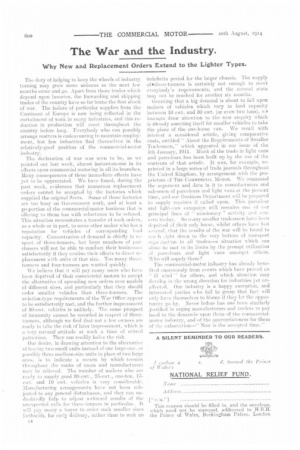The War and the Industry.
Page 2

If you've noticed an error in this article please click here to report it so we can fix it.
Why New and Replacement Orders Extend to the Lighter Types.
The duty of helping to keep the wheels of industry turning may grow more arduous as the next few months come and go. Apart from those trades which depend upon luxuries, the forwarding and shipping trades of the country have so far borne the first shock of ‘var. The failure of particular supplies from the Continent of Europe is now being reflected in the curtailment of work in many industries, and this reduction in production will react throughout the country before long. Everybody who eon possibly arrange matters is endeavouring to maintain employment, but few industries find themselves in the relatively-good position of the connnercial-motor industry.
The declaration of war was seen to be, as we pointed out last week, almost instantaneous in its effects upon commercial motoring in all its branches. Many consequences of those immediate effects have yet to be appreciated. We have found, during the past week, evidences that numerous replacement orders cannot be accepted by the factories which supplied the original fleets. Some of those factories are too busy on Government work, and at least a proportion of the commercial-motor business that is offering to them has with reluctance to be refused. This situation necessitates a transfer of such orders, as a whole or in part, to some other maker who has a reputation for vehicles of corresponding load capacity. Concentration of demand is chiefly in respeet of three-tonners, but large numbers of perchasers will not be able to conduct their businessee satisfactorily if they confine their efforts to direct replacement virh units of that size. Too many threetonners and four-tonners are wanted quickly.
We believe that it will pay many users who have been deprived of their commercial motors to accept the alternative of spreading new orders over models of different sizes, and particularly that they should order smaller vehicles than three-tonners. The aviation-type requirements of the War Office appear to be satisfactorily met, and the further impressment of 30-cwt. vehicles is unlikely. The same prospect of immunity cannot be recorded in respect of threetonners, although we find that not a few owners are ready to take the risk of later impressment, which is a very natural attitude at such a time of stirred patriotism. They can readily halve the risk.
Our desire, in drawing attention to the alternative of buying two small units instead of one large one, or possibly three medium-size units in place of two large ones, is to indicate a means by which tension throughout the ranks of users and manufacturers may be relieved. The number of molders who are ready to supply good 30-cwt., 25-cwt., one-ton, 15cwt. and 10 cwt. vehicles is very considerable. Manufacturing arrangements have not been subjected to any general disturbance, and they can undoubtedly help to adjust awkward reeults of the unexpeeted calls for three-formers in particular. It will pay many a buyer to oeder such smaller sizes forthwith, for early delivery, rather than to wait an e.4 indefinite period for the larger chassis. The supply of ethree-tonners is certainly not enough to meet everybody's requirements, and the normal state may not be reached for another six months.
Granting that a big demand is about to fall upon makers of vehicles which vary in load capacity between 10 cwt. and 30 cwt. (or even two tons), el haseeeto draw attention to the new enquiry which is abready asserting itself for smaller vehicles to take the place of the one-horse van. We recall with interest a considered article, giving comparative costs, entitled " About the Requirements of Smaller Tradesmen," which appeared in our issue of the 5th January, 1911. Much of the trade in light vans and parr:clears has been built up by the use of the contents of that article. It was, for example, reprinted in a large series of frade journals throughout the United kingdom, by arrangement with the proprietors of THE COMMERCIAL MOTOR. We commend the argument and data in it to manufacturers and salesmen of pareelears and light vans at the present time, and our Business Department will be prepared to supply reprints if called upon. This pareelcar and light-van (eunpaien still remains one of cemr principal lines of " missionary " activity and eCIICelli to-day. So many smaller tradesmen have been deprived of their only horse, whilst others have lost eeveral, that the results of the war will he found to renIt Ityhit. down to the. very bottom of transport oreaoizetion in ail trades—a situation which can ohmic be met to its limits by the prompt utilization of pareelears end light vans amongst others. Who will supply these?
The commercial-motor industry has already benefited enormously from events which have proved an " ill wind " for others, and which situation may develop in the wrong direction for industries yet tinaffected. Our industry is a happy exception, and interested parties who fail to grasp that fact will only have themselves to blame if they let the opportunity go by. Never before has one been similarly justified in urging manufacturers and tenders to pay heed to the demands upon them of the commercialmotor indesetry, and of the. appropriateness for them of I he exhertation—" Now is the accepted time."






































